There would hardly be a time when the demand of stainless steel sinks would phase out. People will always install the shiny sinks inside their homes. This is because they are very pocket friendly and offer a great deal of ease while cleaning.
Moreover, there are other additional benefits, as well. Stainless steel sinks also last up to 30 years. They also don’t accumulate rust on them quickly. These benefits make it a straightforward sell for any business.
The two types of stainless-steel sink have different methods of production. These processes give rise to their functionality. In this article, we will look at how to make handmade stainless-steel sinks.
Hãy bắt tay ngay vào nó!
Handmade Stainless-Steel Sinks VS Drawn Stainless Steel Sinks
Có two types of stainless steel sinks. They include handmade stainless-steel sinks and the drawn stainless-steel sinks.
Both types have different manufacturing processes. This means that both have different properties and their own benefits and downsides.
Properties of Handmade Stainless-Steel Sinks
độ dày
For starters, handmade stainless-steel sinks are of higher thickness. These sinks range from around 1.2-1.5mm in thickness.
A drawn stainless-steel sink can’t be this thick. This is because you cannot draw a sheet this thick on a mold in the stretching process. The thickness of a drawn stainless-steel sink cannot exceed 0.8 mm.
The increased thickness muffles the water noises and increases the age of the sink.
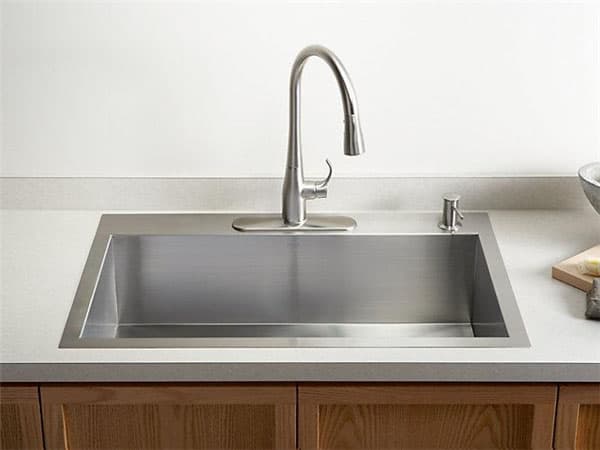
Processing
Another difference between the two variations is the processing. You usually use laser welding while making this type of sink because the equipment and plate requirements are higher.
This makes it have a more excellent quality than the drawn stainless-steel sink.
Moreover, the drawn sink is also pressed in a mold, which is easier to do.
Price
Another difference is the cost attached. With all the fabrication that a handmade sink needs come extra fees as well. The handmade sink costs much more than its other variant.
Không gian sử dụng được
Furthermore, the usable space on a handmade sink is more than the drawn sink. There are tight radius corners on this type of sink, which increases the area of the sink.
Pressed sinks usually have more sweeping corners. This means that their usable size is lesser than their counterparts.
Depth
Handmade stainless-steel sink also offers you more depth! The standard depth of a pressed sink is around 9 inches.
On the other hand, the handmade version has a depth of 10 inches or more. Although this difference is small on paper, that extra inch will come in handy in the kitchen!
nỗ lực làm sạch
Then comes the cleaning effort. The handmade stainless-steel sink is harder to clean. This is because the sink’s surface is flatter because of the tight radius corners we just talked about.
You design a pressed sink in a way that the water flows right down the drain. This allows no water to stand on the sink’s surface, and it becomes much easier to clean.

Manufacturing Process of a Handmade Stainless-Steel Sink
The manufacturing process of a handmade stainless-steel sink is a straightforward one.
To make a drawn stainless-steel sink, you just have to press the sheet onto a mold. This will produce smooth and round sinks that are easy to install.
These sinks are also passed through heat and extra pressure, so it gets torn and beaten a lot. That is even before it reaches your house!
On the other hand, a handmade stainless-steel sink has a different production process. You make this sink by blending, then cutting, and welding the sheets to form a sink. These sinks are usually used in a more professional style kitchen.
Thickness of The Steel
Firstly, the type of stainless steel used here is different. These sinks use the 1.2mm-thick SUS304 steel that is already straightened. This is thicker than the standard stainless steel used.
Bending the Steel
After that, you bend the steel at a right angle. This is different from the drawn sink as in the other variant, you pass the steel through fire and stretch it. These processes damage the thickness of stainless steel.
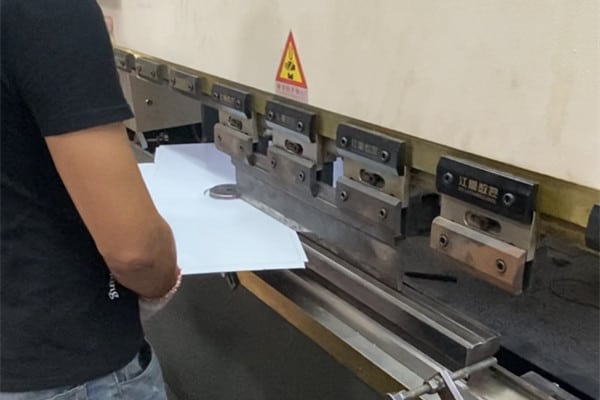
This process does not include any of this.
Manual Welding
The core of the handmade sink is that the product is not stretched and formed. This requires a large amount of manual welding, edge seam welding, snap spot welding, and angle spot welding.
Each welding process requires rich experience and careful operation of the welder to ensure the quality of welding.
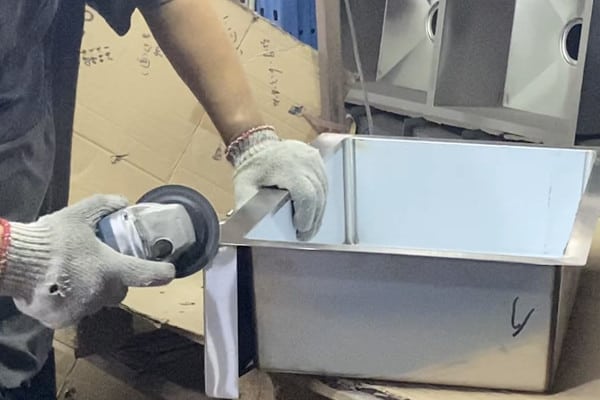
Computerized Welding
This is mainly a process that combines both automated and standard welding.
First of all, you have to butt the bent gap manually. After that, you can start with computer welding.
You can form the double groove on the sink by welding two single grooves together.
Keep in mind, though, just because a computer does the welding doesn’t mean that it’s devoid of error. You still need to thoroughly inspect the sink to make sure there are no flaws.
A quick way to tell if your sink is right or not is to look for the white oxidation line. If there is one, that means that your tank is of high quality.
The central concept of this sink is that the product is not formed or stretched. This requires a large amount of standard welding, snap spot welding, and edge seam welding. Each welding technique requires a careful operation and prosperous technique.

Sanding Belt
You can use a sanding belt to deal with the oxidation marks and the weld marks on your product. The straight-line grinding of the weld marks makes the spots disappear altogether.
Polishing
To get rid of additional marks, you can use polishing to restore the beauty of the sink. This polishing will also increase the value of the sink.
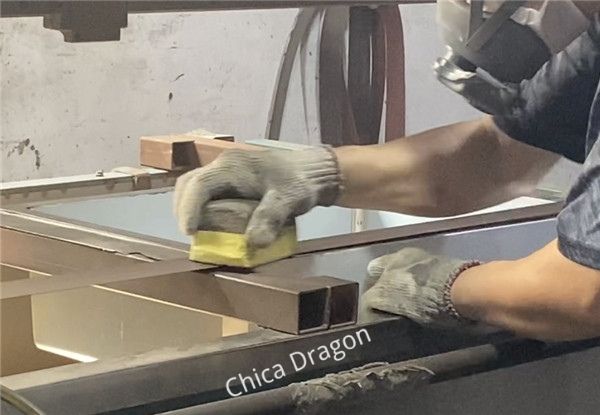
Phần đệm
You then apply pads on all four sides of the sink to protect the sink from rattling while shipping.
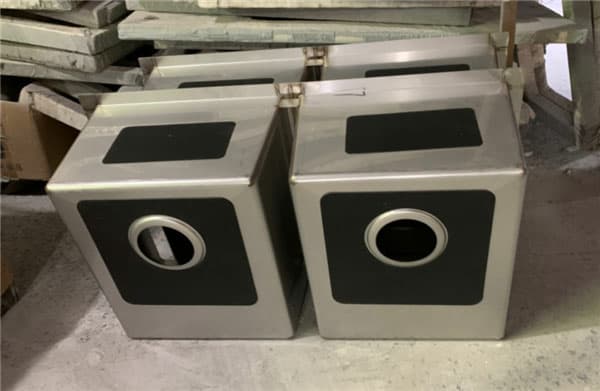
Spray-painting
Then you spray-paint the sink to allow a much thinner coating than that of any ordinary sink. A thinner layer will mean a flatter surface. Also, make sure that the coating material is odorless and it is soluble in water.
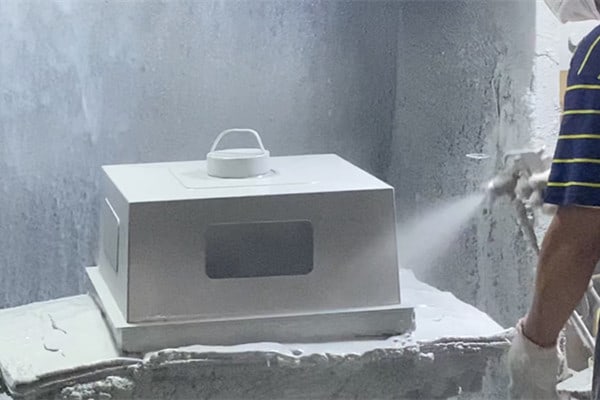
Surface Treatment
You then apply some surface treatment to the sink. You can use fine grinding to refine the surface of the sink.
Bao bì
After that, you pack the sink in a box, and it is ready for shipping!
Câu hỏi thường gặp
Do Stainless Steel Sinks Scratch Easily?
Stainless steel sinks are resistant to cracks and minor chipping. However, they are likely to have scratches after everyday use. Also, if the water stays in your sink, it will develop water spots. The sink is easy to clean, but it does require regular maintenance to look good.
What Grade of Stainless Steel Is Used in The Sinks?
300 or 304 series stainless steel is the most common grade found. It comes with an 18/8 grade. Another familiar series found in stainless steel sinks is the 316. It is also known as the surgical grade with 18/10 grade stainless steel.
What Is the Most Popular Kitchen Sink?
Stainless steel is the most popular kitchen sink. It offers a contemporary look when you pair it with granite, wood or stone countertops.
Even when it comes to durability, the stainless-steel sink is the way to go. The 16-gauge stainless steel sink is enough to withstand any contact while you wash your dishes.
What Damages Stainless Steel?
You can damage stainless steel with vinegar, chlorine, and table salt. Make sure you never soak the stainless steel in solutions containing these. Long term exposure will damage the sink.
Từ cuối cùng
Stainless steel offers many variations and each with its different market. These variations are due to the process if manufacturing. The main difference between the handmade and drawn stainless steel sinks is in the making. The processes highlighted above would give you an insight when choosing.
Chúc may mắn!











2 Những suy nghĩ trên "Chậu rửa inox thủ công được sản xuất như thế nào?”
Pingback: Làm thế nào để kiểm tra bồn rửa bằng thép không gỉ thủ công? - Rồng Chica
Pingback: Không có bán kính không chìm - Chica Dragon